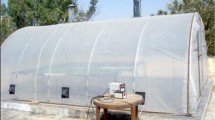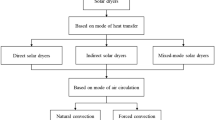Abstract
A natural convection poly house walk-in type solar tunnel dryer was designed and used for drying surgical cotton on industrial scale. This article deals with the basic design criterion used for development of solar tunnel dryer and result of drying of surgical cotton in actual use. A batch of surgical cotton of 600 kg by mass, having an initial moisture content of 40% wet basis from which 210 kg of water is required to be removed to get a desired moisture content of about 5% wet basis, is used as the drying load in designing the dryer. A drying time of 7–8 h is assumed for the anticipated test location (Udaipur, 27° 42′ N, 75° 33′ E) with an expected average solar irradiance of 5.5 kW m−2. Average cost of drying one batch of surgical cotton in a solar tunnel dryer has been worked out to be approximately 4.63 USD as compared to 30.00 USD in the existing diesel fired dryer.








Similar content being viewed by others
Abbreviations
- W :
-
Mass of product, kg
- C p :
-
Specific heat of water, kJ kg−1°C−1
- C a :
-
Specific heat of air, kJ kg−1C−1
- T d :
-
Drying temperature, °C
- T a :
-
Ambient temperature, °C
- T e :
-
Temperature of moist air at chimney outlet, °C
- M w :
-
Mass of water to be removed during drying, kg
- m w :
-
Mass of water to be removed per hour, kg h−1
- λ :
-
Latent heat of vaporization, kJ kg−1
- m f :
-
Final moisture content, %
- m i :
-
Initial moisture content, %
- t d :
-
Assumed drying time, h
- Q :
-
Total energy required, kJ
- Q t :
-
Energy required per hour, kJ h−1
- Q a :
-
Rate of air required, m3s−1
- Q c :
-
Rate of air flow in chimney, m3s−1
- r :
-
Radius of dryer (m)
- L :
-
Length of dryer (m)
- Rh am :
-
Ambient relative humidity, %
- t d :
-
Drying period, h
- I :
-
Incident solar radiation, MJ h−1 m−2
- η:
-
Dryer efficiency
- ρ a :
-
Density of air at ambient temperature, kg m−3
- ρ e :
-
Density of exit air, kg m−3
- D a :
-
Actual draft
- D i :
-
Produced draft
References
Arinze EA (1986) Solar energy for crop drying in developing countries. In: Proceeding of a workshop on Solar Drying in Africa, pp 128–146, 21–24 July 1986
Bassey MW, Whitfield MJCC, Koroma EY (1986) Problems and solution for natural-convection solar crop drying. In: Bassey MW, Schmidt OG (eds) Proceedings of workshop on solar drying in Africa, Senegal, Dakar, pp 207–232, 21–24 July 1986
Bena B, Fuller RJ (2002) Natural convection solar dryer with biomass back-up heater. Sol Energy 72(1):75–83
Chen H, Hernandez CF, Huang T (2005) A study of the drying effect on lemon slices using a closed-type solar dryer. Sol Energy 78(1):97–103
Chua KJ, Chou SK (2003) Low cost drying methods for developing countries. Trends Food Sci Technol 14(12):519–528
Duffie WA, Beckman J (1991) Solar engineering of thermal systems, 2nd edn. Wiley, New York
El-Shaitry MA, Muller J, Muhlbauer W (1991) Drying fruit and Vegetables with solar energy in Egypt. AMA 22(4):61–64
Esper A, Muhlbauer W (1996) Solar tunnel dryer. Plant Res Dev 44(4):16–64
Forson FK, Nazha MAA, Akuffo FO (1996) Natural convection solar crop dryers of commercial scale design in Ghana: design, construction and performance. Ambient Energy 17(3):123–130
Forson FK, Nazha MAA, Akuffo FO, Rajakaruna H (2007) Design of mixed-mode natural convection solar crop dryers: application of principles and rules of thumb. Renew Energy 32:2306–2319
Hossain MA, Bala BK (2007) Drying of hot chilli using solar tunnel drier. Sol Energy 81:85–92
Hossain MA, Woods JL, Bala BK (2005) Simulation of solar drying of chilli in solar tunnel drier. Int J Sustain Energy 24(3):143–153
Jain R (2007) Clean technologies: implementation and technology transfer challenges. Clean Technol Environ Policy 9:77–79
Maddhlopa A, Jones SA, Kalenga Saka JD (2002) A solar air heater with composite abosorber system for food dehydration. Renew Energy 27:27–37
Muhlbauer W (1986) Present status of solar crop drying. Energy Agric 5:121–137
Rathore NS, Panwar NL (2007) Renewable energy sources for sustainable development. New India Publishing Agency, New Delhi
Rathore NS, Kurchania AK, Panwar NL (2007) Non conventional sources of energy. Hinamshu Publication, Udaipur
Sacilik K, Keskin R, Elicin A (2006) Mathematical modelling of solar tunnel drying of thin layer organic tomato. J Food Eng 73(3):231–238
Sahin A, Dincer I (2002) Graphical determination of drying process and moisture transfer parameters for solids drying. Int J Heat Mass Transf 45:3267–3273
Van Arsdel WB, Copley MJ (1963) Food dehydration, vol 1. The AVI Publishing Company, Westport
Author information
Authors and Affiliations
Corresponding author
Rights and permissions
About this article
Cite this article
Rathore, N.S., Panwar, N.L. Design and development of energy efficient solar tunnel dryer for industrial drying. Clean Techn Environ Policy 13, 125–132 (2011). https://doi.org/10.1007/s10098-010-0279-3
Received:
Accepted:
Published:
Issue Date:
DOI: https://doi.org/10.1007/s10098-010-0279-3




